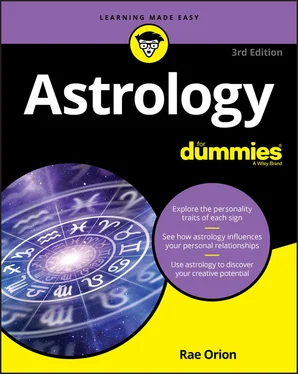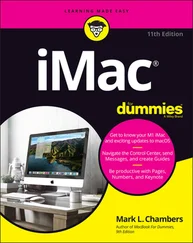Despite the title of this book, I assume that you’re no fool. Whether you’re an absolute beginner or a long-time devotee of the cosmic art, I assume that you have enough common sense to know that astrology offers understanding — not winning lottery numbers. It can help you become your most fulfilled self. It can even make predictions, and in the hands of highly skilled practitioners, those predictions can be spot-on. But despite its association with alchemy, divination, and the occult, astrology isn’t magic.
I assume that you’re intrigued by the perspective astrology offers and curious about how it might apply to you, and I take it for granted that you are especially interested in your own horoscope. Most of us are, and for good reason: investigating your own chart is edifying and revealing, making it perhaps the single most instructive step you can take while learning astrology. But scrutinizing your own chart is more than an exercise for novices. Even seasoned astrologers brood over their own charts. And when they hear of a newly discovered celestial body or an ancient technique that has been resuscitated after centuries of disuse, I guarantee that they try it out first with their own charts. Exploring your personal chart is the work of a lifetime.
I assume that you have easy access to the internet. Whether you get there by way of a laptop, a smart phone, a computer in a public library, or a device that has yet to be invented, internet access will enable you to create birth charts on the spot and to track the daily positions of the Sun, the Moon, and the planets.
Finally, I assume you know that astrology isn’t about fate or predestination. It’s about possibility and propensity, about making the most of your strengths, recognizing your shortcomings, understanding other people, and aligning yourself with the cosmos. When I was learning astrology, I was taught that “the stars impel; they do no compel.” Sir Francis Bacon (1561-1626), father of the scientific method, put it this way: “There is no fatal necessity in the stars; but that they rather incline than compel.” Four centuries have passed since then, and it’s still true.
Four icons sprinkled throughout this book serve as road signs. Here’s what the icons mean:
 In an ideal world, every planetary placement, aspect, and transit discussed in the text would be accompanied by an example from the life of a flesh-and-blood human being. In the real world, book space is limited, so I’m able to use comparatively few such examples. This icon highlights those examples. In most cases, real-life examples feature movie stars, musicians, writers, artists, politicians, and other well-known figures, past or present. From time to time, I write about people I know personally. In those instances, the names have been changed. The astrology remains the same.
In an ideal world, every planetary placement, aspect, and transit discussed in the text would be accompanied by an example from the life of a flesh-and-blood human being. In the real world, book space is limited, so I’m able to use comparatively few such examples. This icon highlights those examples. In most cases, real-life examples feature movie stars, musicians, writers, artists, politicians, and other well-known figures, past or present. From time to time, I write about people I know personally. In those instances, the names have been changed. The astrology remains the same.
 Certain facts and principles are essential to reading a birth chart. I discuss most of them in the early chapters. But when you need to recall a fact in order to understand a particular facet of a birth chart, I try to remind you, gently, using this icon.
Certain facts and principles are essential to reading a birth chart. I discuss most of them in the early chapters. But when you need to recall a fact in order to understand a particular facet of a birth chart, I try to remind you, gently, using this icon.
 It’s impossible to talk about astrology without coming smack up against astronomy and mathematics. Whenever I give a nuts-and-bolts scientific explanation of an astrological (or astronomical) phenomenon, I warn you upfront with this icon. Want to skip the explanation? Go ahead. Most of the time, you can ignore it and still be on track.
It’s impossible to talk about astrology without coming smack up against astronomy and mathematics. Whenever I give a nuts-and-bolts scientific explanation of an astrological (or astronomical) phenomenon, I warn you upfront with this icon. Want to skip the explanation? Go ahead. Most of the time, you can ignore it and still be on track.
 A paragraph marked with this icon may suggest an easier way of doing something. It may point you to a book, an app, or a podcast that covers material similar to that being discussed in the text. It may suggest a way to address a problem that could arise with a certain planetary configuration in a chart. Or it may tell you how to, say, seduce a Capricorn. Never let it be said that astrology isn’t useful.
A paragraph marked with this icon may suggest an easier way of doing something. It may point you to a book, an app, or a podcast that covers material similar to that being discussed in the text. It may suggest a way to address a problem that could arise with a certain planetary configuration in a chart. Or it may tell you how to, say, seduce a Capricorn. Never let it be said that astrology isn’t useful.
This book introduces you to the basics of astrology — and more. The Cheat Sheet, available online at www.dummies.com , provides a handy summary of the symbols and meanings of the signs, planets, houses, and aspects, along with a few nonessential components of your chart that might interest you. Take a look.
To get it, go to www.dummies.com and search for “Astrology For Dummies Cheat Sheet.”
There is grandeur in astrology. Using a symbolic language that brims with mythology and metaphor, it speaks to the psyche and resonates with the soul. Yet it can also be down-to-earth and specific. It covers a lot of ground and benefits from an astonishing array of techniques and approaches. That’s why, if you take it up, you could be studying astrology for the rest of your life. It’s that interesting. It’s that fun.
So where should you begin? Chapter 1covers the basics. Chapter 2tells you how to get a copy of your birth chart. Once you are in possession of that essential document, you’re ready to immerse yourself in the most fascinating study of human beings ever invented. I suggest that you begin by turning to Chapters 4through 7to read about your Sun sign and, secondarily, the signs of a few other people you know. After that, you might turn to Chapters 8, 9, and 10to read about your Moon and your planets; to Chapter 11to find out about your rising sign; and to Chapter 12to read about the houses that your planets occupy. Or maybe you’d rather go directly to Chapter 15to see how your sign is likely to hit it off with, say, Taurus. That’s okay too.
Ultimately, you may end up wandering through the pages of this book in no particular order. That’s not my recommendation. As far as I’m concerned, the chapters are numbered for a reason. But there’s nothing wrong with hopping around. Whatever approach you take, I hope that you will rejoice in — and benefit from — the wisdom of the stars.
Part 1
Mapping Your Place in the Cosmos
IN THIS PART …
Grasp the basics of astrology and see what’s included in a horoscope.
Find out how to obtain your birth chart to use as a reference throughout the book.
Ramble through a brief history of astrology’s ups, downs, and changing influence over the centuries.
Chapter 1
An Astrological Overview: The Horoscope in Brief
IN THIS CHAPTER
 Picturing the solar system
Picturing the solar system
 Rambling through the zodiac
Rambling through the zodiac
 Classifying the signs by polarity, modality, and element
Classifying the signs by polarity, modality, and element
 Contemplating the Sun, the Moon, and the planets
Contemplating the Sun, the Moon, and the planets
Читать дальше

 In an ideal world, every planetary placement, aspect, and transit discussed in the text would be accompanied by an example from the life of a flesh-and-blood human being. In the real world, book space is limited, so I’m able to use comparatively few such examples. This icon highlights those examples. In most cases, real-life examples feature movie stars, musicians, writers, artists, politicians, and other well-known figures, past or present. From time to time, I write about people I know personally. In those instances, the names have been changed. The astrology remains the same.
In an ideal world, every planetary placement, aspect, and transit discussed in the text would be accompanied by an example from the life of a flesh-and-blood human being. In the real world, book space is limited, so I’m able to use comparatively few such examples. This icon highlights those examples. In most cases, real-life examples feature movie stars, musicians, writers, artists, politicians, and other well-known figures, past or present. From time to time, I write about people I know personally. In those instances, the names have been changed. The astrology remains the same. Certain facts and principles are essential to reading a birth chart. I discuss most of them in the early chapters. But when you need to recall a fact in order to understand a particular facet of a birth chart, I try to remind you, gently, using this icon.
Certain facts and principles are essential to reading a birth chart. I discuss most of them in the early chapters. But when you need to recall a fact in order to understand a particular facet of a birth chart, I try to remind you, gently, using this icon. It’s impossible to talk about astrology without coming smack up against astronomy and mathematics. Whenever I give a nuts-and-bolts scientific explanation of an astrological (or astronomical) phenomenon, I warn you upfront with this icon. Want to skip the explanation? Go ahead. Most of the time, you can ignore it and still be on track.
It’s impossible to talk about astrology without coming smack up against astronomy and mathematics. Whenever I give a nuts-and-bolts scientific explanation of an astrological (or astronomical) phenomenon, I warn you upfront with this icon. Want to skip the explanation? Go ahead. Most of the time, you can ignore it and still be on track. A paragraph marked with this icon may suggest an easier way of doing something. It may point you to a book, an app, or a podcast that covers material similar to that being discussed in the text. It may suggest a way to address a problem that could arise with a certain planetary configuration in a chart. Or it may tell you how to, say, seduce a Capricorn. Never let it be said that astrology isn’t useful.
A paragraph marked with this icon may suggest an easier way of doing something. It may point you to a book, an app, or a podcast that covers material similar to that being discussed in the text. It may suggest a way to address a problem that could arise with a certain planetary configuration in a chart. Or it may tell you how to, say, seduce a Capricorn. Never let it be said that astrology isn’t useful. Picturing the solar system
Picturing the solar system










